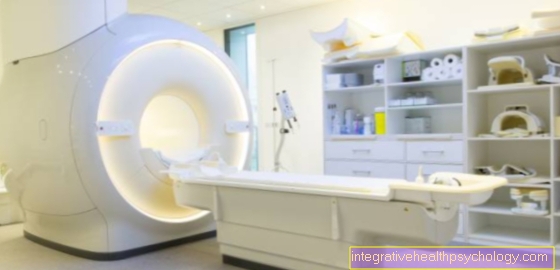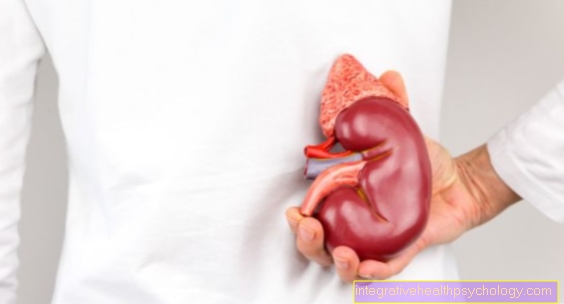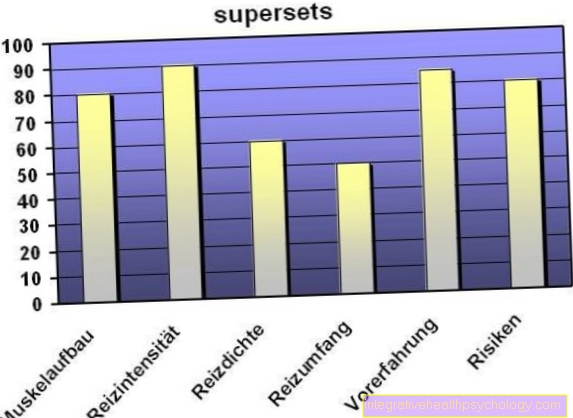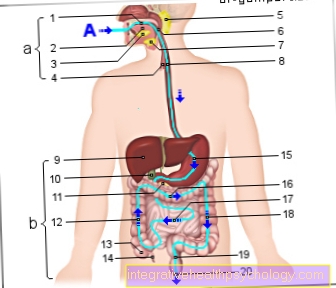Signs of pancreatic cancer
Note
All information given here is only of a general nature, tumor therapy always belongs in the hands of an experienced oncologist!
Synonyms
Pancreatic carcinoma (or more precise term in the narrower sense: ductal adenocarcinoma of the pancreas), pancreatic carcinoma, pancreatic cancer, pancreatic tumor
English: pancreatic carcinoma

First signs of pancreatic cancer

The main symptom (key symptom) of pancreatic cancer is the initially painless development of jaundice (Jaundice), which causes noticeable yellowish discoloration of the skin and eyes.
The reason for the development of jaundice in pancreatic cancer patients is the fact that the bile ducts become very narrow as the cancer grows.
The yellowing of the skin, as a sign of the end stage of pancreatic cancer, appears very late. Only in cases in which the direct transition between the excretory duct and the duodenum (Major duodenal papilla) is blocked by the tumor, jaundice can be understood as a relatively early warning sign.
A clearly perceptible sign that pancreatic cancer is present is the appearance of constantly increasing pain, which is particularly evident in the abdomen and flanks.
As with inflammation of the pancreas, the pain can also radiate into the thoracic spine area.
The more unspecific signs include an enormous weight loss within a very short time and noticeably heavy sweating during the night (night sweats). One speaks of noticeable night sweats as soon as the affected patients state that they have to change their clothes and / or duvet covers several times a night because of the high level of fluid loss.
The rise in core body temperature (fever) is also one of the unspecific signs of cancer.
Since the actual function of the pancreas is strongly influenced and restricted by the cancer, indigestion and diarrhea are also signs of pancreatic cancer.
In cases in which the endocrine, hormone-producing part of the pancreas is affected, the normal production of insulin in particular falls to a minimum.
In the course of this underproduction of insulin, so-called secondary diabetes can develop in many patients. The uptake of sugar in the cells and the actual utilization of sugar are severely impaired.
In the course of diabetes, further symptoms can occur, which are basically not caused by the pancreatic cancer, but only by its concomitant disease.
The most common symptoms include a noticeably frequent need to urinate and a simultaneous feeling of strong thirst.
In addition, the affected patients often feel increasingly weak and complain of persistent fatigue and exhaustion.
There is a general decline in performance of the sick.
In extreme cases, it can even lead to a sudden inexplicable deterioration in vision.
It can also be seen that wounds generally heal much more slowly and often begin to ooze.
Read more about this topic: How can you recognize pancreatic cancer?
Illustration pancreatic cancer

Pancreatic cancer -
(Pancreatic cancer)
- Liver - Hepar
- Pancreas - Pancreas
- Main bile duct -
Common bile duct - Head of the pancreas -
Caput pancreatis - Pancreatic tumor (malignant)
ductal adenocarcinoma - Body of
Pancreas -
Corpus pancreatis - Pancreatic duct
(Main execution course) -
Pancreatic duct - Tail of
Pancreas -
Cauda pancreatisauda - Spleen - Sink
- Stomach - Guest
Risk factors:
A. - Chronic pancreatitis -
To smoke cigarettes -
Alcoholism - very fatty
and protein-rich diet
Signs / Symptoms:
B - yellowing of the conjunctiva -
Yellowing of the skin -
Lightening of the stool -
Dark urine -
Upper abdominal pain
Therapy:
C - Operation (in advance
MRI, ultrasound) -
radiotherapy
(in combination with chemotherapy) -
chemotherapy
(Drugs-cytostatics)
You can find an overview of all Dr-Gumpert images at: medical illustrations
Pancreas anatomy
The pancreas (pancreas) is an organ that belongs to the gastrointestinal tract and takes on important tasks in the course of digestion and nutrient absorption.
The large gland comes in the C-shaped loop of the Duodenum (Duodenum) to lie down and extends from there to the left kidney and the spleen.
It can be divided into two functional units. One of these units (endocrine pancreas) is responsible for the production and release of hormones like insulin or Glucagon responsible, the other functional unit (exocrine pancreas) forms different ones Digestive enzymeswhich are directed into the lumen of the duodenum through an excretory duct system.
Illustration of the pancreas

- Body of
Pancreas -
Corpus pancreatis - Tail of
Pancreas -
Cauda pancreatisauda - Pancreatic duct
(Main execution course) -
Pancreatic duct - Duodenum lower part -
Duodenum, inferior pars - Head of the pancreas -
Caput pancreatis - Additional
Pancreatic duct -
Pancreatic duct
accessorius - Main bile duct -
Common bile duct - Gallbladder - Vesica biliaris
- Right kidney - Ren dexter
- Liver - Hepar
- Stomach - Guest
- Diaphragm - Diaphragm
- Spleen - Sink
- Jejunum - Jejunum
- Small intestine -
Intestine tenue - Colon, ascending part -
Ascending colon - Pericardium - Pericardium
You can find an overview of all Dr-Gumpert images at: medical illustrations
causes
Cancers of the pancreas (Pancreatic cancer) are relatively widespread and are becoming increasingly common. Possible causes for the development of pancreatic cancer have not yet been precisely identified. Still, it is believed that Smoke, the excessive consumption of alcohol, one high fat diet and various Hereditary diseases greatly increase the likelihood of developing pancreatic cancer.
Most pancreatic tumors develop in the area of the head of the pancreas, i.e. in the immediate vicinity of the duodenum. In about 20 percent of the disease cases, tumor growth starts from Pancreatic body.
Most signs of illness (Signs, symptoms) one Pancreatic cancer appear quite late in the course of the disease. Inaccurate (unspecific) signs such as fever, Exhaustion, Weight loss and Night sweatscaused by cancers in general (but can also have other reasons), are caused by a non-specific defense reaction (Immune response) of the body and causes an increased metabolism of cancer cells.
These signs do come along occasionally in earlier stages pancreatic cancer, but are usually not recognized as threatening and only in exceptional cases lead to early detection of the cancer. On the contrary, this disease is characterized by the fact that, as a rule any early symptoms are fatally absent.
Then come in advanced stages of pancreatic cancer more serious and, above all, perceived signs as more threatening pancreatic cancer, which usually lead to its discovery.
This (Jaundice, Indigestion, secondary Diabetes mellitus with its consequences, Pain) are then due to the displacing (invasive) Growth of the tumor (Tumor) to explain. This pushes the through its increasing volume Main bile duct (Common bile duct) so that it becomes a Biliary congestion (Cholestasis) is coming.
Indigestion and Jaundice (Jaundice) are the consequence. The tumor can also displace the healthy tissue of the pancreas so that it can no longer work properly (exocrine and endocrine pancreatic insufficiency). this leads to Diarrhea, Fatty stools and one Diabetes mellitus with all its consequences (increased thirst, increased amount of urine, etc.).
So can the tumor Grow towards the back and above all through pressure (compression) located there Affect nerves, muscles and the spinecausing pressing or stabbing pain in that area (in the middle back, but also on the flanks or in the upper abdomen) can lead.
In rare cases, cancer of the pancreas can be caused by a unspecific activation of Immune system lead to increased coagulability of the blood and a Clot formation (thrombosis) condition. If inexplicable clot formation occurs repeatedly in a patient, pancreatic cancer should also be considered as a possible cause.
blood
Non-specific activation of the immune system in pancreatic cancer leads to a slight increase in so-called inflammation markers in the blood. For example, the number of immune cells (Leukocytes), the CRP value and the sedimentation rate are above the norm.
Occasionally there is also an increased tendency to form blood clots due to the tumor (thrombosis), which then brings its own problems, such as phlebitis (Thrombophlebitits migrans), Swelling (Edema) or pulmonary embolism due to the clot being carried over.
The tumor can also cause so-called accompanying inflammation of the pancreas, which in turn leads to a considerable increase in the inflammation values in the blood, but also draws attention to itself through a relevant increase in the concentration of the pancreatic enzymes (especially the so-called lipase value) in the blood .
Read more on the subject at: Elevated lipase
Signs of end-stage pancreatic cancer
What makes pancreatic cancer so dangerous is that because of that relatively late occurrence stronger and clearly assignable signs early detection of the disease is very rare. As a rule, pancreatic cancer is discovered either by accident or it is only revealed in the end-stage through corresponding symptoms. The tumor is then already quite large and has very often already scattered (metastasized). As a result, the chances of recovery are usually low.
As the disease progresses, the symptoms worsen as the disease progresses. However, palliative measures can alleviate the patient's suffering in the end-stage of pancreatic cancer.
Through a The tumor grows into large branches of the main artery (Celiac trunk or superior mesenteric artery) a pancreatic cancer achieves that Stage III cancer.
Stage IV is in the presence of remote evacuation via the blood path (hematogenous metastasis) in front.
Read more about this topic at: End-stage pancreatic cancer





























